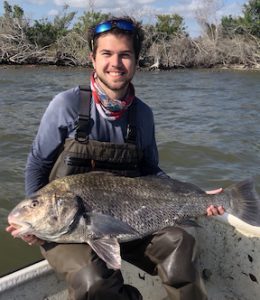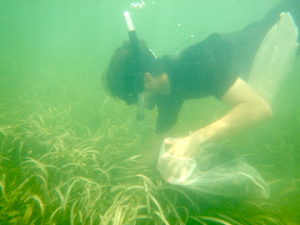By Patrick Farrar
Four outstanding graduate students in UF’s School of Natural Resources and Environment have received the prestigious Graduate Research Fellowship Program awards from the National Science Foundation. The highly-competitive five-year fellowship grants them substantial financial support for their research and education. The SNRE recipients are: seagrass
- Nick Gengler
- Maggie Jones
- Ben Lowe
- Adam Searles
This series of blog posts serves to highlight these four students and their research interests.
Adam Searles, rightfully so, was thrilled to receive an NSF Graduate Research Fellowship.
“I was pretty excited, jumping up and down,” he said.
A lifelong nature and animal lover, Adam grew up fishing in Florida’s Indian River Lagoon. His attachment and experience with fish and other marine life morphed into scientific pursuit.
“I wanted to do my part to help the lagoon,” he said.

Adam earned a Bachelor’s degree in biology with a concentration in marine science at the University of Central Florida (UCF) before coming to UF for his Ph.D. During his time at UCF, he conducted research throughout the Indian River Lagoon and realized his interest in habitat ecology. Here at UF he studies seagrass habitats and the animals that live there.
“They form really unique communities compared to any other marine habitats,” he said.
Choosing SNRE
The combination of his advisors and labs brought Adam to UF and the Interdisciplinary Ecology doctoral program in SNRE. He is interested in the seagrass research Dr. Laura Reynolds conducts in the Soil and Water Sciences Department, and Dr. Charlie Martin’s work in fisheries ecology at the UF/IFAS Nature Coast Biological Station.
“They were the perfect fit,” he said.
Scientists say many aquatic habitats in Florida have changed in recent years. One example, seen in springs and other areas, is how dense mats of algae have replaced the flowing beds of seagrass that once coated the bottom. Growing up by the Indian River Lagoon, Adam has seen this change firsthand there.
“We know those two habitats support unique communities, but we don’t know why,” Adam said. “Figuring out why is going to be crucial to understanding how our ecosystem services are going to change over time, so I’d like to figure out the why.”

Research
Adam is currently working on a literature review, scouring the latest scientific journal articles on these topics to understand the current scope of research in the field. He is also working on a gut content analysis, inspecting the half-digested material that sheepshead and sea bream have been eating.
Why? The two species are closely related and have both historically been present in the Indian River Lagoon, but sea bream numbers have recently exploded.
“It’s been an amazing increase,” he said.
Adam thinks this might have something to do with the changing seagrass to algae ratio. Looking into their diets, literally, could bring relevant details to light. He looks forward to getting out and doing fieldwork to further understand, and benefit, the Indian River Lagoon.
 0
0
